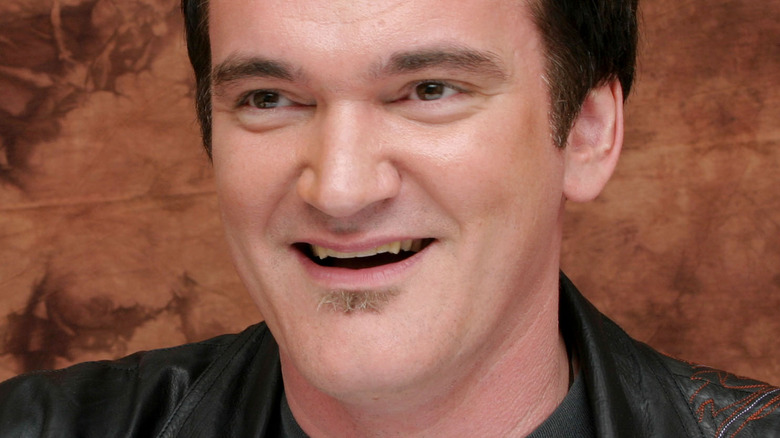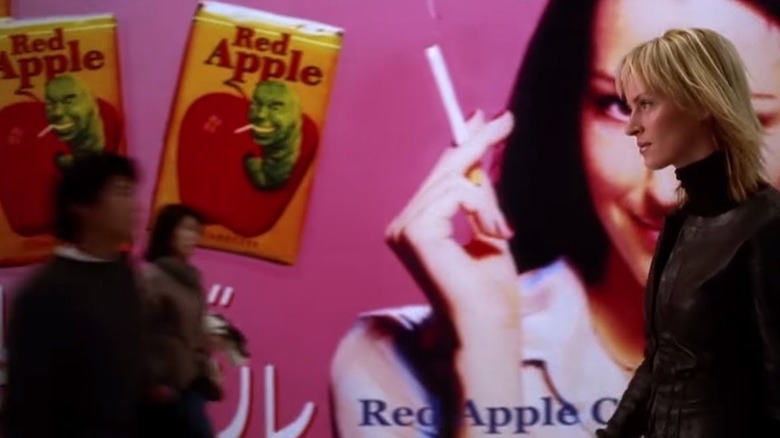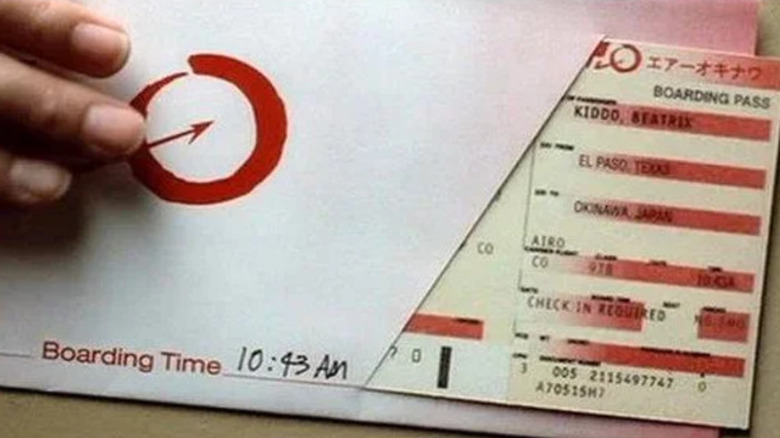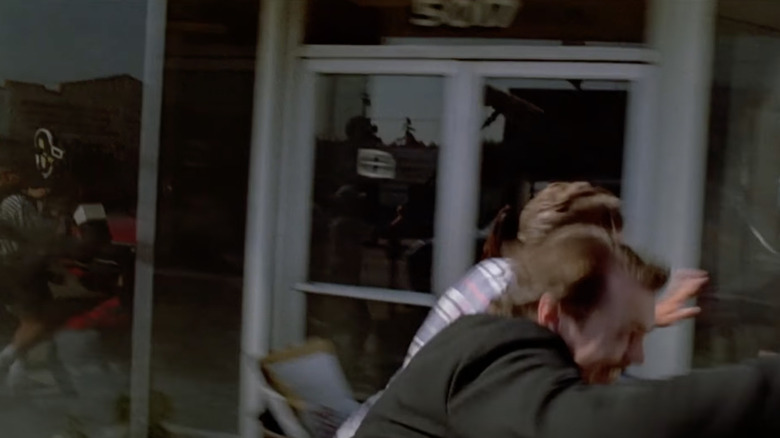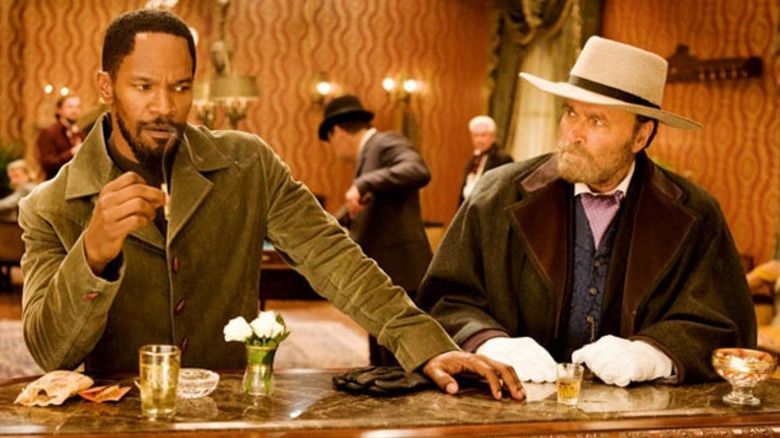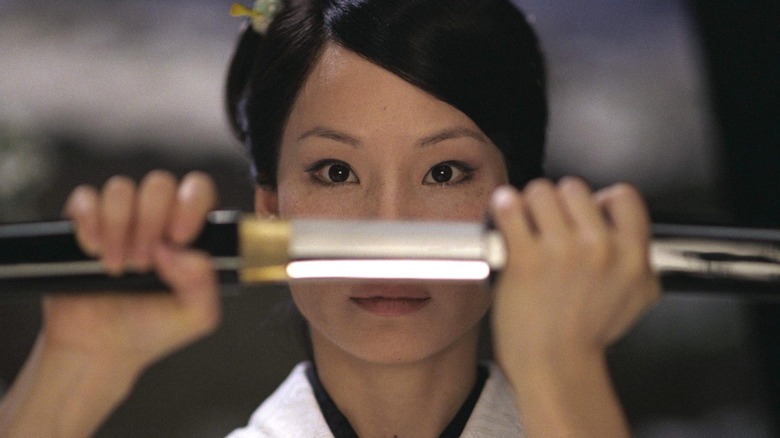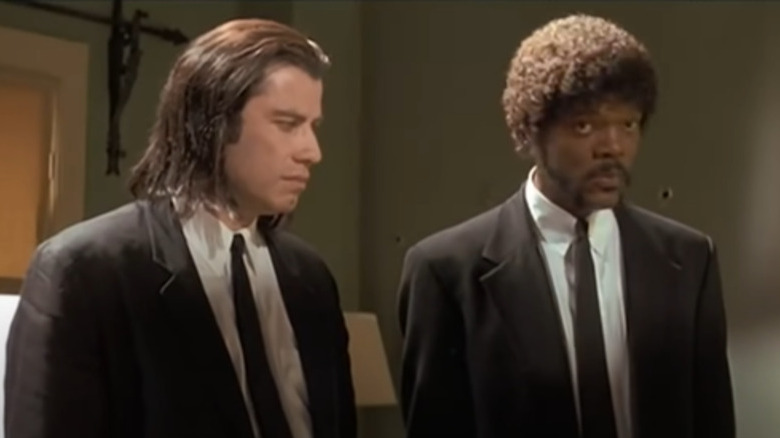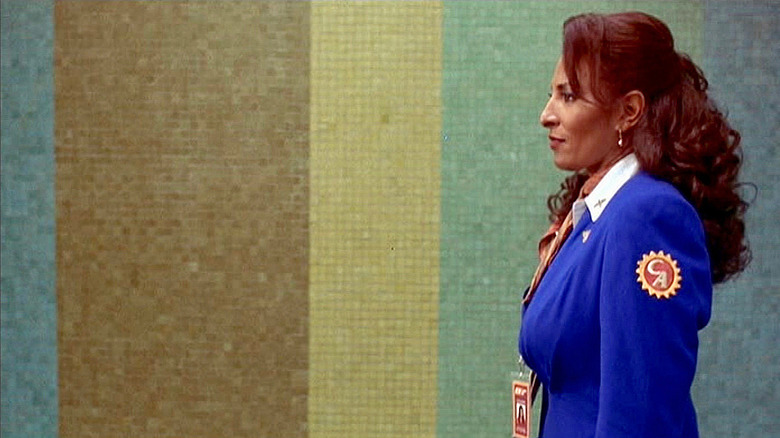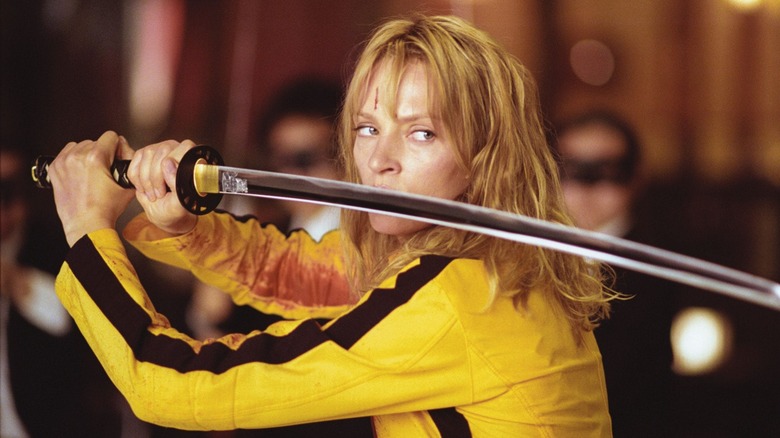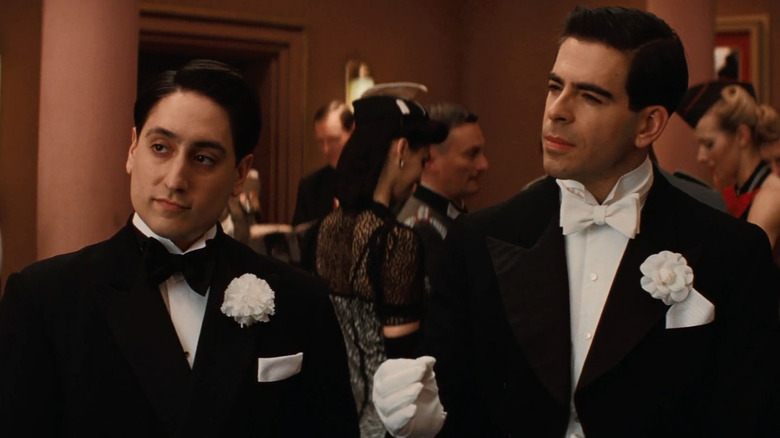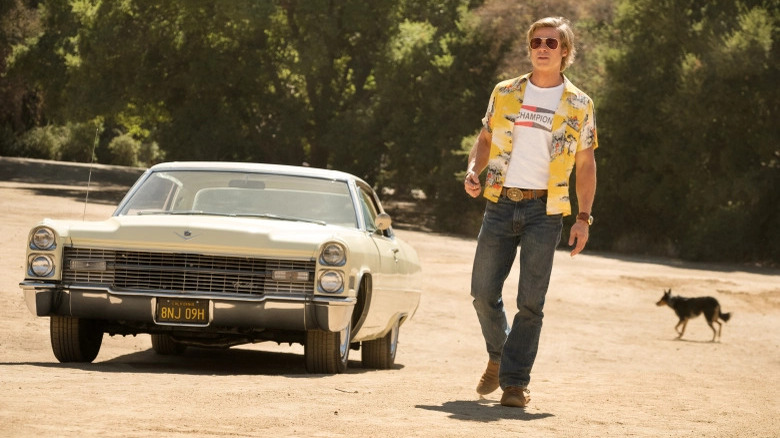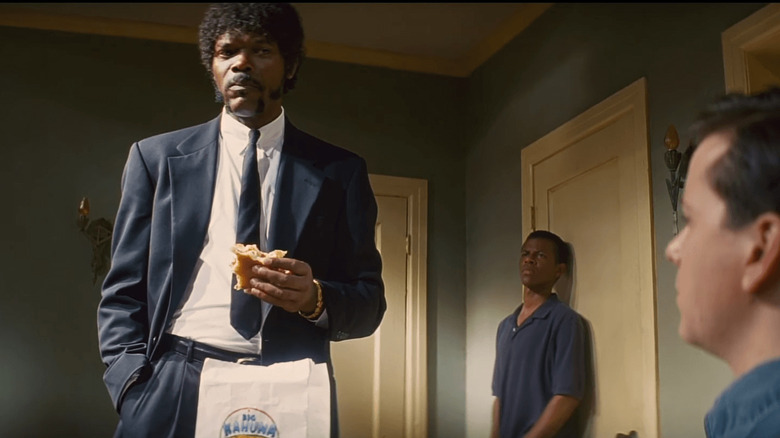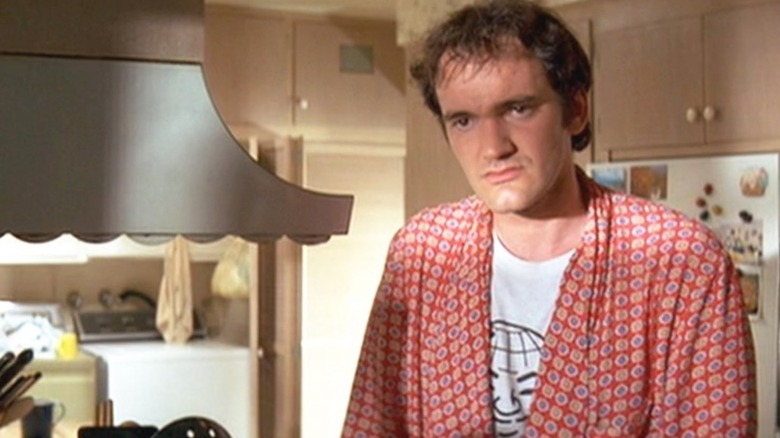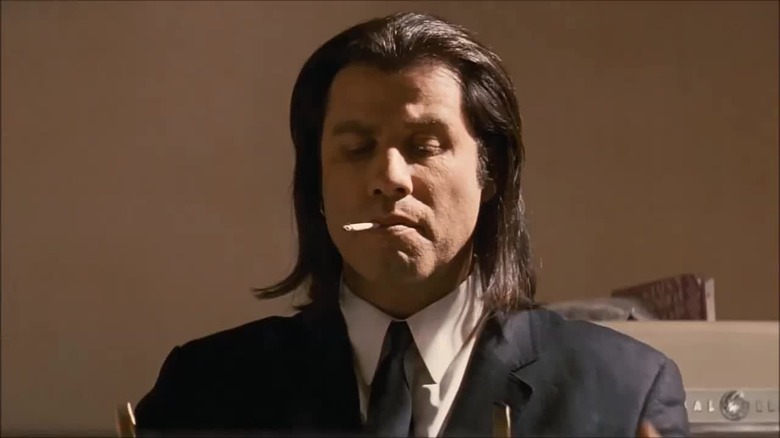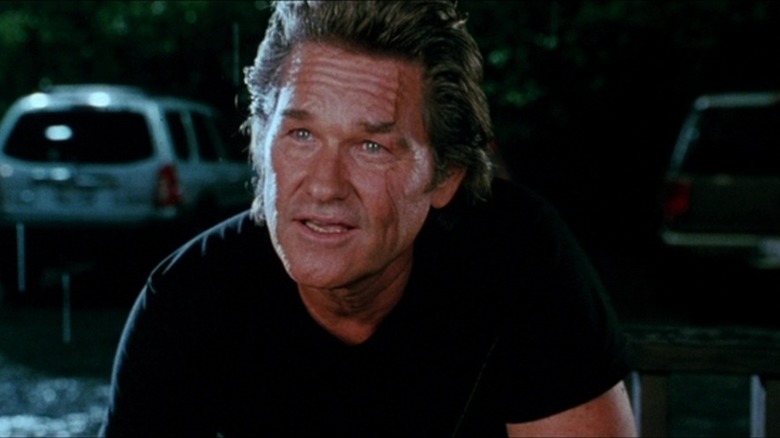Small Details You Missed In Quentin Tarantino Movies
One of the rare filmmakers today who still seems to be growing in both popularity and influence with each release, Quentin Tarantino has directed and written nine feature films, including his debut, 1992's "Reservoir Dogs." Supposedly, his 10th will be his last; fans, critics and cinephiles at large hope not.
With a penchant for stylized, violent set pieces, rapid-fire dialogue sequences, and numerous nods to his pop culture inspirations, Tarantino's movies have earned legions of fans worldwide. They've also garnered prestigious accolades, including multiple Academy Awards. In short, nothing else feels like a Quentin Tarantino movie — and a big part of that is the filmmaker's attention to detail, loaded with Easter eggs and references, many of which made his films feel like a shared universe long before the term was coined.
Here are just a few of the small details and nods audiences may have missed in their initial viewings of Tarantino's celebrated filmography, from subtle links connecting each of the movies to bloopers that made it into the final cut. Each of Tarantino's projects have a surprising amount of depth behind what audiences see on the screen; here is the meaning behind such easily overlooked details.
Red Apple Cigarettes are lit up in multiple movies
Tarantino is fond of bringing recurring elements across his filmography, with one of the most noticeable instances of this being fictional brands created for his movies. One of the most prominent is Red Apple Cigarettes, introduced in "Pulp Fiction," with the fictional cigarette brand smoked by several different characters in the 1994 film. The cigarette brand also makes appearances in "The Hateful Eight" (as rolling tobacco, since the film is set in 1887; Mexican Bob even makes reference to "Manzana Roja," which is Spanish for ... well, you know) and the Tarantino-helmed sequence from 1995's anthology film "Four Rooms."
Interestingly, Red Apple Cigarettes have appeared in two films not directed by Tarantino: 1996's "From Dusk Till Dawn," written by and starring Tarantino, and in a poster ad during "Romy and Michelle's High School Reunion"; with Tarantino dating "Romy and Michelle" star Mira Sorvino at the time, the cigarette ad was a clever in-joke included as a nod to Tarantino's work.
Other notable in-film advertising for Red Apple Cigarettes include a Japanese billboard glimpsed in "Kill Bill: Volume 1" and an end credits scene from "Once Upon a Time ... in Hollywood" that has Leonardo DiCaprio's Rick Dalton praising the product's "better drag, more flavor ... less throat burn."
The Bride's full name is revealed in Kill Bill Vol. 1
One of the big mysteries to emerge from "Kill Bill: Volume 1" revolved around the name of Uma Thurman's vengeful protagonist, referred to in the film and its marketing as "The Bride." Whenever the character's name was mentioned in "Volume 1" and the first half of 2004's "Kill Bill: Volume 2," it had been audibly censored to maintain the mystery.
However, the reveal of The Bride's full name is in "Volume 1," long before the villainous Elle Driver (Daryl Hannah) announces it in "Volume 2." You just need to be really, really focusing on the screen to see it.
After regaining consciousness in an El Paso hospital, The Bride orders a one-way plane ticket to travel to Okinawa, intending to obtain a katana there from retired sword maker Hattori Hanzo (Sonny Chiba). In a blink-and-you'll-miss-it moment, the printed plane ticket clearly has the name "Beatrix Kiddo" displayed in the top corner. As "Volume 2" would eventually confirm, her name is Beatrix Kiddo.
The crew is visible in Reservoir Dogs
Tarantino made his feature-length directorial debut with 1992's "Reservoir Dogs," a relatively low-budget crime film following a group of thieves in the aftermath of a disastrous jewelry store heist. One of the many elements that made the film stand out was Tarantino's decision not to show the actual robbery. In a flashback, viewers briefly glimpse the chaotic aftermath — and judging by a mistake in that sequence, perhaps it's better that most of the film is dialogue in a nondescript warehouse.
As Mr. Pink (Steve Buscemi) recounts how he barely escaped from the police after the botched heist, he can be seen sprinting down a busy Los Angeles street with the cops in pursuit on foot. After pushing his way past two pedestrians, the film crew's reflection is visible in a storefront window in the background, from the camera crew themselves to a boom mic used to capture the chaotic audio. A seasoned filmmaker likely would have seen such potential for error while mapping out the shot and blacked out the windows or employed some other obfuscation technique; a modern filmmaker would simply use CGI in post to fix it. But since Tarantino was neither, his rookie mistake survived the final cut — and in a way, perhaps crystallizes the adrenaline thrill of early-'90s indie cinema.
With the benefit of home video, Tarantino's momentary gaffe is now visible for anyone paying attention with the remote handy.
The original Django appears in Django Unchained
Tarantino has included nods and homages to spaghetti westerns — genre movies largely produced by Italian studios — in his work for years and leaned into these influences for his own "Django Unchained." The 2012 film starred Jamie Foxx as the eponymous freed slave, determined to rescue his wife Broomhilda (Kerry Washington) from the sadistic plantation owner Calvin Candy (DiCaprio). Posing as someone interested in buying a slave for gladiatorial fights, Django meets with Candy who is in competition with a rival slaveowner Amerigo Vessepi, played by veteran spaghetti western actor Franco Nero.
After Veseppi loses to Candy, he briefly speaks with Django at the bar, aware of how the bounty hunter spells his name after the two introduce themselves. Nero played the original version of Django in the 1966 spaghetti western film "Django" (and its 1987 sequel "Django Strikes Again") with his casting in "Django Unchained" a direct tribute to that role. In a visual touch to Nero's spaghetti western, Veseppi wears bright white gloves, a nod to Nero's iteration of Django having his hands maimed over the course of the 1966 film.
O-Ren Ishii times her own death
With "Kill Bill" being told out of chronological order, the first assassin that The Bride takes her revenge on isn't Vernita Green (Vivica A. Fox) as shown in the "Vol. 1'" opening but O-Ren Ishii (Lucy Liu). In the four years that The Bride was rendered comatose by the cabal of global assassins, O-Ren seized power as one of the most powerful Yakuza leaders in Japan. And after The Bride cuts through O-Ren's private army at a Tokyo restaurant, the two former associates engage in their own private duel, with O-Ren correctly predicting how long the fight will last.
While O-Ren is surprised that The Bride wields a sword forged by the retired Hanzo, she estimates that the impending duel won't last five minutes. O-Ren is correct in her prediction — albeit, not in the way that she anticipated. The Bride cuts off the top of her head, killing her, and the length of O-Ren and The Bride's swordfight lasts four minutes and 59 seconds, fulfilling O-Ren's lethal prophecy.
Pulp Fiction's bullet holes presage a shooting
Perhaps the most prominent storyline in Tarantino's celebrated 1994 film "Pulp Fiction" is one that follows hitmen Vincent Vega (John Travolta) and Jules Winnfield (Samuel L. Jackson) throughout Los Angeles. While retrieving a briefcase belonging to their employer Marsellus Wallace (Ving Rhames), Vincent and Jules get into an impromptu gunfight with an unnamed character (Alexis Arquette) looking to avenge their friends. Surprising the two assassins, the character completely unloads a pistol at the two men, with the bullets striking the wall behind Vincent and Jules before they lethally return fire.
In a blooper that made it into the final film, the bullet holes in the wall behind Vincent and Jules are present before the shooting even begins, as glimpsed in certain shots in the apartment. This suggests that the scene of Vincent and Jules talking in front of the bullet-ridden wall was filmed before much of the sequence in the apartment. Amusingly, the claims from Jules that a miracle saved him and Vincent from mortal harm may be undercut by the knowledge that the bullet holes were there all along.
Jackie Brown's opening is referenced in Once Upon a Time ... in Hollywood
The opening title sequence to 1997's "Jackie Brown" sets the tone for Tarantino's adaptation of Elmore Leonard's 1992 novel "Rum Punch." From its grainy, color-saturated cinematography and Pam Grier's casting in the title role to the 1973 Bobby Womack song "Across 110th Street," Tarantino pays direct homage to '70s blaxploitation cinema. The memorable sequence would later be featured in a direct callback by Tarantino in "Once Upon a Time ... in Hollywood."
"Jackie Brown" opens with the eponymous protagonist walking confidently through a brightly-colored tiled hallway in LAX (a Los Angeles landmark dating back to the 60s) before breaking into a run to board flight passengers on time at the gate. The same hallway is featured in "Once Upon a Time" when Rick Dalton (DiCaprio) and Cliff Booth (Brad Pitt) make their triumphant return to Los Angeles, with Rick's new wife Francesca (Lorenza Izzo). In both sequences, the characters exude a sense of cool as they walk through the airport, quietly hinting at their status quo before their respective narratives' kick into high gear.
Kill Bill has a direct nod to Bruce Lee
Given how the late actor and martial artist is depicted in "Once Upon a Time," Tarantino has a complicated stance regarding the legacy of Bruce Lee. However, Lee received a decidedly more favorable nod in "Kill Bill: Volume 1" with The Bride's choice in fashion while she is in Tokyo. From cruising through the Japanese capital on her motorcycle to her memorable sword fight in the House of Blue Leaves, The Bride wears a black and bright yellow tracksuit and helmet evocative of Lee.
This iconic outfit is a visual homage to the martial arts legend's similar ensemble in his posthumously released final film "Game of Death" in 1978. The Bride's iteration of the yellow and black outfit would become one of the more recognizable images of the character, with The Bride wearing the tracksuit on the "Volume 1'" theatrical poster.
How would The Bride fare against Cliff Booth? Possibly better than Bruce Lee did.
An Inglourious Basterd gets a shoutout in Once Upon a Time
"Once Upon a Time ... In Hollywood" blends real-life figures and true events in the 1960s entertainment scene with fictional characters and twists on established history, all in service to Tarantino's love letter to 1969 Los Angeles. A prime example of the blur between actual history and Tarantino's imagination occurs when Rick Dalton takes an extended sojourn in Italy to star in European films. Among the filmmakers that Rick works with while in Europe is a real director — and one amusingly name-dropped in Tarantino's 2009 film "Inglourious Basterds."
While infiltrating a Nazi film premiere in Paris during "Inglourious Basterds," Allied soldier Donny Donowitz (Eli Roth) uses the alias Antonio Margheriti while posing as an Italian director at the event. Antonio Margheriti is an actual Italian filmmaker, who directed feature films from 1960 to 1989 and is credited in "Once Upon a Time ... In Hollywood" for helming Rick in the fictional crime movie "Operazione Dyn-o-mite." Donowitz's pseudonym in "Basterds" and the passing reference to Margheriti in "Once Upon a Time" serve as Tarantino's two-fold tribute to the late director.
Tarantino brings back classic cars
"Once Upon a Time ... In Hollywood" is a lavish, painstakingly faithful recreation of Los Angeles in 1969, drawing from Tarantino's own memories of the city. One of the most prominent elements he includes in the film are the classic cars that Cliff Booth drives around L.A., one belonging to himself and the other to his best friend and boss, Rick Dalton. In obtaining these throwback automobiles, Tarantino revisited some of the cars he had memorably used in his past projects.
Rick is chauffeured around the city in his yellow 1966 Cadillac Coupe de Ville by Cliff after receiving a DUI prior to the events of the film; that car was previously driven by Mr. Blonde (Michael Madsen) in 1992's "Reservoir Dogs," with the actual car owned by Madsen who personally lent it to the production. Cliff himself, meanwhile, drives a blue 1968 Volkswagen Karmann Ghia — the same make and model previously driven by The Bride in 2004's "Kill Bill: Volume 2."
Big Kahuna Burger has its own cinematic legacy
If there is one Tarantino-created fictional brand employed in his movies more than Red Apple Cigarettes, it might be the fast food chain Big Kahuna Burger. The fast food chain has also appeared in productions by Tarantino's friends as well, including "From Dusk Till Dawn," "Romy and Michelle's High School Reunion," and The Adventures of Sharkboy and Lavagirl."
Within Tarantino's directorial work, paper cups and bags from Big Kahuna Burger appear in "Four Rooms" and "Fiction." In the latter film, Jules takes the time to specifically name-drop and enjoy a Big Kahuna Burger, washing it down with a refreshing soda before things take a lethal turn.
More subtle appearances of Big Kahuna Burger in Tarantino films include a bus-mounted ad in "Once Upon a Time ... In Hollywood" and Kurt Russell's Stuntman Mike in "Death Proof" mentioning a billboard near one of the franchise's locations.
Is all this talk of tasty burgers making you hungry? You might be in luck — Big Kahuna Burgers have been known to become pop-up stores at times, typically in promotion of various Tarantino efforts.
Tarantino appears in many of his films
Much like Alfred Hitchcock and other directors before him, Tarantino has made it a point to cameo in many of his movies. It's a fun tidbit for Tarantino fans to look out for — albeit, one where he might have a slight advantage over other filmmakers since Tarantino considered himself an actor for many years and has starred in films like "From Dusk Til Dawn" and "Destiny Turns on the Radio."
Appearing as Mr. Brown in "Reservoir Dogs," Tarantino delivered the film's opening riff on Madonna — and was quickly dispatched. In "Pulp Fiction," the filmmaker played coffee-loving Jimmie, eager to help with a body disposal as long as it went down before his wife Bonnie got home.
Tarantino briefly popped up as the bar owner in "Death Proof" (and was drinking real shots, according to Eli Roth) and "Django Unchained" brought along what might have been the most sizable role he gave himself, as an explosives obsessed ... Australian?
One of Tarantino's more overlooked roles in his own films is in the closing segment of "Four Rooms," in which he lays out the terms of a bloody wager inspired by an old "Alfred Hitchcock Presents" episode.
More subtle Tarantino cameos include his voice on an answering machine in "Jackie Brown," a dead Nazi (and later, an actor) in "Basterds," and narrating "The Hateful Eight." Did he have cameos in "Hollywood" (supposedly that's him screaming "cut" at the end of the Dalton commercial) and "Kill Bill" (some think he was one of the Crazy 88)? That depends, perhaps, on your interpretation of the word.
Tarantino builds family histories in a shared universe
Though it isn't explicitly stated within the films themselves, Tarantino has created familial links between some of the figures in his filmography. Mr. Blonde's real name in "Reservoir Dogs" is revealed to be Vic Vega, since claimed in Tarantino interviews to be the brother of Vincent Vega from "Pulp Fiction." In various interviews over the years, Tarantino has alluded to the fact that he once had an idea for a "Vega Brothers" movie that would bring John Travolta and Michael Madsen's character's together (and back from the dead), but like many Tarantino ideas, it never came to fruition.
"I did think about the idea of the Vega brothers, taking place before the movies," Tarantino said in 2016, one of the few times he's ever addressed the topic. "Vincent was in Amsterdam and his brother Vic/Mr Blonde comes and visits him, and they get into some adventure."
Tarantino's penchant to weave hidden family histories would later continue with his historical films. In "Basterds," Michael Fassbender's British intelligence officer Archie Hicox is related to duplicitous outlaw English Pete Hicox (Tim Roth) in "Hateful Eight."
As for recurring names in Tarantino's initial films, it's no secret that he wrote his earliest scripts — "Natural Born Killers," "True Romance," "Reservoir Dogs," "Pulp Fiction," etc — during overlapping periods, some with the expectation they might not get made (or would be realized by a different filmmakers). It's unsurprising, then, that Jimmie in "Pulp Fiction" and Mr. White in "Reservoir Dogs" share the surname "Dimmick," Tom Sizemore's "NBK" detective and Blonde's parole officer in "Reservoir Dogs" is Scagnetti, the cop in "Dogs" and a murdered cop in "NBK" (and later, a murderer in "Django") share the last name Nash, and Alabama Worley from "Romance" shares a first name with Mr. White's referenced old partner in "Reservoir Dogs" (and, incidentally, Pam Grier's character in one of Tarantino's favorite films, 1971's "Women in Cages"). What may have started as unintended script shorthand, it seems, might have become a Tarantino trademark.
Death Proof references Kurt Russell's celebrated career
One of Tarantino's favorite collaborators in recent years has been Kurt Russell, who appeared prominently in "The Hateful Eight" and "Once Upon a Time ... In Hollywood." The two first got together for "Death Proof" (part of his "Grindhouse" collaboration with Robert Rodriguez), with Russell playing against type as a serial killer named Stuntman Mike who preys on young women, using his own modified car as a murder weapon. Death Proof" contains several references to Russell's own long-running career, all while subverting audience expectations about his tendency to play heroic roles.
When Stuntman Mike introduces himself to a group of young women who will unwittingly become his next set of victims, he reveals that he previously worked long ago as a stuntman on the television series "The Virginian." As a child actor, one of Russell's earliest roles was on an episode of "The Virginian," with the reference being a nod to Russell's acting origins. A more subtle reference to Russell's career in "Death Proof" is his character Jack Burton's white tank top from "Big Trouble in Little China," hung up on the wall of the Austin dive bar where he stalks his prey.
